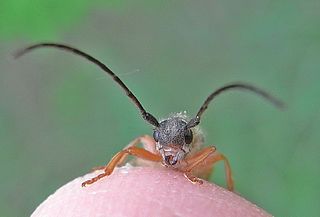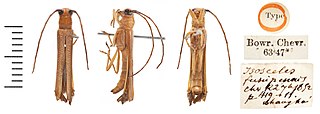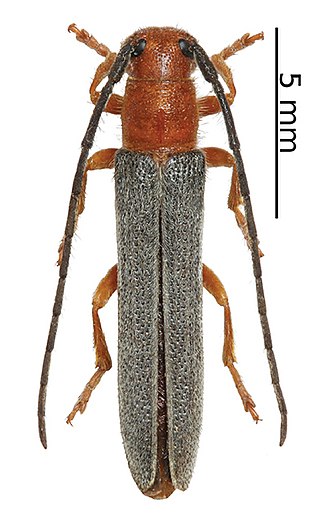
Purea, Tevahine-'ai-roro-atua-i-Ahurai, also called Oborea, was a queen from the Landward Teva tribe and a self-proclaimed ruler of all Tahiti. Queen Purea is known from the first famous European expeditions to Tahiti. She ruled as chieftainess of her tribe area in 1767–1768, when she was encountered by the expedition of Samuel Wallis.

Oberea is a genus of longhorn beetles, most of which are stem borers of various plants, including blackberries and their relatives.
Oberea affinis is a species of longhorn beetle in the tribe Saperdini in the genus Oberea, discovered by Leng & Hamilton in 1896.
Oberea bisbipunctata is a species of flat-faced longhorn beetle in the tribe Saperdini in the genus Oberea, discovered by Maurice Pic in 1916.
Oberea ocellata, the sumac stem borer, is a species of flat-faced longhorn beetle in the tribe Saperdini in the genus Oberea, discovered by Haldeman. It is a notable pest of trees and can cause serious damage if not stopped.
Oberea consentanea is a species of beetle in the family Cerambycidae. It was described by Francis Polkinghorne Pascoe in 1867. It is known from Borneo.
Oberea rubetra is a species of beetle in the family Cerambycidae. It was described by Francis Polkinghorne Pascoe in 1858. It is known from Sumatra, Borneo and Malaysia.
Oberea neavei is a species of beetle in the family Cerambycidae. It was described by Per Olof Christopher Aurivillius in 1914.
Oberea discoidalis is a species of beetle in the family Cerambycidae. It was described by Karl Jordan in 1894. It is known from the Republic of the Congo, Gabon, Cameroon, the Ivory Coast, and Sierra Leone. It contains the variety Oberea discoidalis var. occidentalis.
Oberea erythrostoma is a species of beetle in the family Cerambycidae. It was described by Heller in 1915. It is known from the Philippines.

Oberea euphorbiae is a species of beetle in the family Cerambycidae. It was described by Ernst Friedrich Germar in 1813 originally under the genus Saperda. It has a wide distribution in Europe. It feeds on Euphorbia palustris.
Oberea ferruginea is a species of beetle in the family Cerambycidae. It was described by Thunberg in 1787.

Oberea fuscipennis is a species of beetle in the family Cerambycidae. It was described by Chevrolat in 1852.
Oberea griseopennis is a species of beetle in the family Cerambycidae. It was described by Bernhard Schwarzer in 1925. It feeds on Cinnamomum camphora.

Oberea linearis is a species of beetle in the family Cerambycidae. It was described by Carl Linnaeus in 1761, originally under the genus Cerambyx. It has a wide distribution throughout Europe. It is preyed upon by Opilo pallidus, and serves as a host for the parasitic wasp species Dolichomitus messor and Phaenolobus terebrator. It feeds on Juglans regia, Corylus avellana, Ulmus glabra, Ostrya carpinifolia, and Carpinus betulus. It contains the varietas Oberea linearis var. parallela.
Oberea nigriventris is a species of beetle in the family Cerambycidae. It was described by Henry Walter Bates in 1873. It is known from Malaysia, Japan, Laos, Vietnam, China, Myanmar, and Taiwan.

Oberea ruficeps is a species of beetle in the family Cerambycidae. It was described by Fischer von Waldheim in 1842.
Oberea trilineata is a species of beetle in the family Cerambycidae. It was described by Chevrolat in 1858. It contains the varietas Oberea trilineata var. nigrosternalis.





